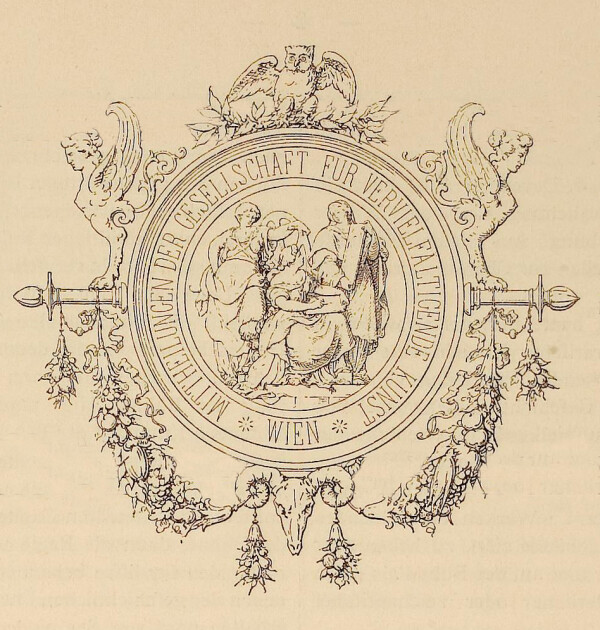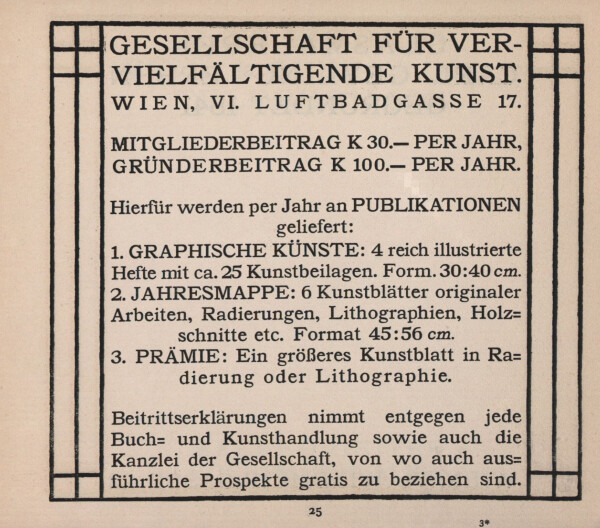Society for Reproductive Art

Signet of the Society for Reproducing Art, in: Mittheilungen der Gesellschaft für vervielfältigende Kunst, Heft 1 (1892).
© Heidelberg University Library
In 1871, the Society for Reproductive Art was founded in Vienna with the goal to preserve and promote printmaking techniques and skills. In 1896, Gustav Klimt was elected to the society’s board.
The Society for Reproductive Art was founded in Vienna in 1871. It emerged from its predecessor, the Vienna Art Club, also known as Association for the Promotion of the Visual Arts, which had been established in 1830 and whose aim it had been “to stimulate the activity of living national artists through the purchase of successful works and to spread public interest in the visual arts.” The new society deliberately withdrew from this obligation to purchase works and instead focused exclusively on the cultivation of reproductive art. In the founding year, the Society also appointed a board, whose members included the architect Heinrich Ferstel, the painter Ferdinand Laufberger, and the art historian Rudolf Eitelberger. The Society for Reproductive Art remained in existence for six decades and only disbanded in 1935.

Advertising for membership of the Society for Reproducing Art, in: Vereinigung bildender Künstler Österreichs Secession (Hg.): XX. Ausstellung der Vereinigung bildender Künstler Oesterreichs Secession Wien. März April Mai 1904, Ausst.-Kat., Secession (Vienna), 26.03.1904–12.06.1904, Vienna 1904.
© Library of the Belvedere, Vienna
Publications
The Society initially published album booklets and gallery portfolios. Just one year after its foundation, it edited the periodical Mittheilungen der Gesellschaft für vervielfältigende Kunst. Its art magazine Die graphischen Künste, first appeared in 1879, contained numerous reproductions of copper engravings, etchings, woodcuts, and color prints.
Gustav Klimt and the Society for Reproductive Art
From 1894 on, the Society published a work on theater history entitled Die Theater Wiens [“Vienna’s Theaters”], which was to comprise six volumes. According to an 1895 article in Die graphischen Künste, the purpose of this series was to present “as faithful a picture as possible of the development of Viennese stage life from its beginnings to the most recent times.” The Society engaged renowned artists like Gustav Klimt and Franz Matsch. They were to create portraits of famous actors and actresses for this work of the theater. Gustav Klimt, who according to the minutes of a meeting from 1896 had also been elected to the Society’s board, decided on a painting of the actor Josef Lewinsky, to whom he sent the following message on 19 May 1894:
Letter from Gustav Klimt to Josef Lewinsky

Gustav Klimt: Portrait of Josef Lewinsky as Carlos in Clavigo, 1895, Österreichische Galerie Belvedere
© Belvedere, Vienna
“Honorable Sir! The Society for Reproductive Art is going to publish a major work on Vienna’s theaters, most of all the old Burgtheater […]. I have been assigned the task of painting an artist of the old Burgtheater […]. I have taken the liberty to decide on painting your portrait, honorable sir […].”
The color reproduction of Portrait of Josef Lewinsky as Carlos in Clavigo (1895, Belvedere, Vienna) was published in the second volume of Theaterwerk – Das k. k. Hofburgtheater seit seiner Begründung [“Theater Work – The Imperial-Royal Court Theater Since Its Foundation”].
Reproduction Permit
In 1895, the Society for Reproductive Art also published a reproduction of Ernst Klimt’s work Hanswurst on the Fair Stage (1886–1888, Burgtheater, Vienna) in its magazine Die graphischen Künste. The work was reproduced as an etching by the artist Wilhelm Woernle. Gustav Klimt had previously officially permitted the Society to reproduce his deceased brother’s painting in various techniques. According to the written reproduction permit, which has only survived as a transcript, Klimt received 200 guilders (approx. 2,850 euros) in return.
Literature and sources
- Hansjörg Krug: Gustav Klimt selbstredend, in: Tobias G. Natter (Hg.): Gustav Klimt. Sämtliche Gemälde, Vienna 2012, S. 461-504.
- Joseph Meyer: Meyers großes Konversations-Lexikon, Band 7, Leipzig 1907, S. 721-722.
- Mittheilungen der Gesellschaft für vervielfältigende Kunst, Heft 1 (1872), S. 3-6.
- Mittheilungen der Gesellschaft für vervielfältigende Kunst, Heft 3 (1896), S. 9.
- Die Presse, 18.04.1894, S. 9.
- Die Presse, 14.04.1871, S. 14.
- Brief von Gustav Klimt in Wien an Josef Lewinsky (19.05.1894). H.I.N. 38.571, .
- Die Graphischen Künste, N.F., Band 1 (1936), S. 1.
- Die Graphischen Künste, 1. Jg., Heft 2 (1879), S. 1-4.
- Die Graphischen Künste, 18. Jg., Heft 4+5 (1895), S. 97.
- Die Graphischen Künste, 17. Jg., Heft 2 (1894), S. 44 (Umschlag).
- Revers der Gesellschaft für Vervielfältigende Kunst von Gustav Klimt (04/27/1895).
- Gesellschaft für Vervielfältigende Kunst (Hg.): Die Theater Wiens, Band II, Vienna 1894.





